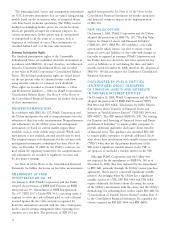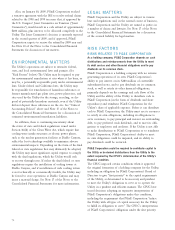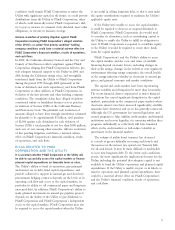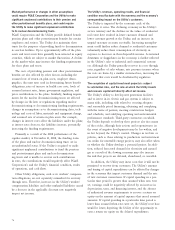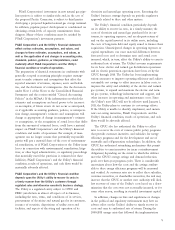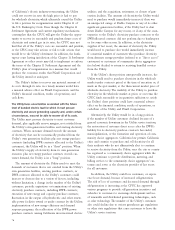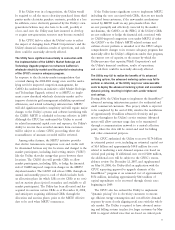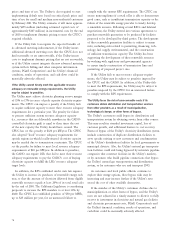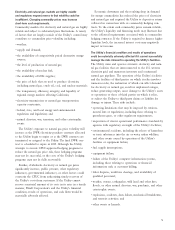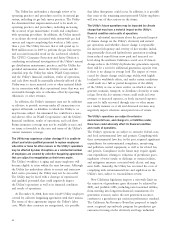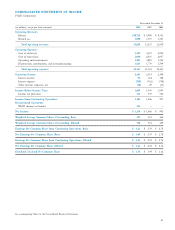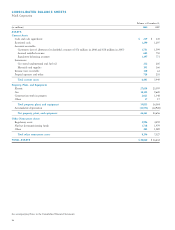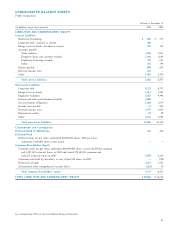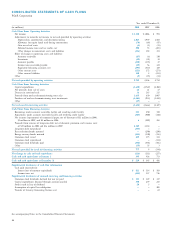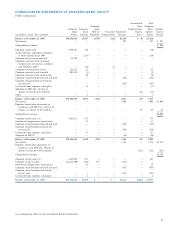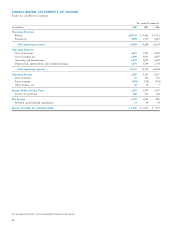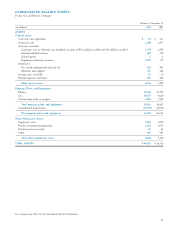PG&E 2008 Annual Report Download - page 81
Download and view the complete annual report
Please find page 81 of the 2008 PG&E annual report below. You can navigate through the pages in the report by either clicking on the pages listed below, or by using the keyword search tool below to find specific information within the annual report.79
Economic downturn and the resulting drop in demand
for energy commodities has reduced the prices of electricity
and natural gas and required the Utility to deposit or return
collateral in connection with its commodity hedging con-
tracts. To the extent such commodity prices remain volatile,
the Utility’s liquidity and fi nancing needs may fl uctuate due
to the collateral requirements associated with its commodity
hedging contracts. If the Utility is required to fi nance higher
liquidity levels, the increased interest costs may negatively
impact net income.
The Utility’s fi nancial condition and results of operations
could be materially adversely affected if it cannot successfully
manage the risks inherent in operating the Utility’s facilities.
The Utility owns and operates extensive electricity and natu-
ral gas facilities that are interconnected to the U.S. western
electricity grid and numerous interstate and continental
natural gas pipelines. The operation of the Utility’s facilities
and the facilities of third parties on which it relies involves
numerous risks, the realization of which can affect demand
for electricity or natural gas, result in unplanned outages,
reduce generating output, cause damage to the Utility’s assets
or operations or those of third parties on which it relies,
or subject the Utility to third-party claims or liability for
damage or injury. These risks include:
• operating limitations that may be imposed by environ-
mental laws or regulations, including those relating to
greenhouse gases, or other regulatory requirements;
• imposition of stricter operational performance standards by
agencies with regulatory oversight of the Utility’s facilities;
• environmental accidents, including the release of hazardous
or toxic substances into the air or water, urban wildfi res,
and other events caused by operation of the Utility’s
facilities or equipment failure;
• fuel supply interruptions;
• equipment failure;
• failure of the Utility’s computer information systems,
including those relating to operations or fi nancial
information such as customer billing;
• labor disputes, workforce shortage, and availability of
qualifi ed personnel;
• weather, storms, earthquakes, wild land and other fi res,
fl oods, or other natural disasters, war, pandemic, and other
catastrophic events;
• explosions, accidents, dam failure, mechanical breakdowns,
and terrorist activities; and
• other events or hazards.
Electricity and natural gas markets are highly volatile
and regulatory responsiveness to that volatility could be
insuffi cient. Changing commodity prices may increase
short-term cash requirements.
Commodity markets for electricity and natural gas are highly
volatile and subject to substantial price fl uctuations. A variety
of factors that are largely outside of the Utility’s control may
contribute to commodity price volatility, including:
• weather;
• supply and demand;
• the availability of competitively priced alternative energy
sources;
• the level of production of natural gas;
• the availability of nuclear fuel;
• the availability of LNG supplies;
• the price of fuels that are used to produce electricity,
including natural gas, crude oil, coal, and nuclear materials;
• the transparency, effi ciency, integrity, and liquidity of
regional energy markets affecting California;
• electricity transmission or natural gas transportation
capacity constraints;
• federal, state, and local energy and environmental
regulation and legislation; and
• natural disasters, war, terrorism, and other catastrophic
events.
The Utility’s exposure to natural gas price volatility will
increase as the DWR electricity purchase contracts allocated
to the Utility begin to expire or as the DWR contracts are
terminated or assigned to the Utility. The fi nal DWR con-
tract is scheduled to expire in 2015. Although the Utility
attempts to execute CPUC-approved hedging programs to
reduce the natural gas price risk, these hedging programs
may not be successful, or the costs of the Utility’s hedging
programs may not be fully recoverable.
Further, if wholesale electricity or natural gas prices
signifi cantly increase, public pressure, other regulatory
infl uences, governmental infl uences, or other factors could
constrain the CPUC from authorizing timely recovery of
the Utility’s costs from customers. If the Utility cannot
recover a material amount of its costs in its rates in a timely
manner, PG&E Corporation’s and the Utility’s fi nancial
condition, results of operations, and cash fl ows would be
materially adversely affected.



